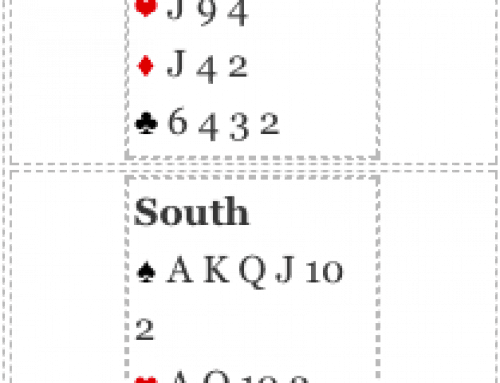Dlr: North Vul: Both
Scoring: IMPs
Scoring: IMPs
| ||
| ||
�
| North | East | South | West |
1 | Pass | 3NT (1) | All Pass |
�
(1) A good 15 to a bad 17.
Opening lead:� 
Dummy plays the 8, you play the 10 and South, the ace,
At trick two South leads the� 
At trick three South leads the� 
| This is going to be a hard hand to defeat with the opponents holding about 28 HCP not to mention the strong diamond side suit that has now been established. In any case, let’s start with the lead, the�  7. It is not a 4th best lead. If it were, there would be four cards above the seven in the three remaining hands.You can see four cards above the 7 in your hand and dummy and South has won the trick with the ace, a fifth card higher than the seven. So if it is not a 4th best lead, what is it? It could be from the Q97, but this would be an unusual lead. It is more likely second high from four or five small, usually headed by a 9, exceptionally, a 10. Why not 4th best from these holdings? Because the lead of a low card against notrump suggests strength and tells partner you wouldn’t mind the suit returned. But if you want another returned, do NOT lead low from a worthless suit.After this pep talk it should be clear not to return a spade, but rather put all your eggs in the heart basket and fire the� 7. It is not a 4th best lead. If it were, there would be four cards above the seven in the three remaining hands.You can see four cards above the 7 in your hand and dummy and South has won the trick with the ace, a fifth card higher than the seven. So if it is not a 4th best lead, what is it? It could be from the Q97, but this would be an unusual lead. It is more likely second high from four or five small, usually headed by a 9, exceptionally, a 10. Why not 4th best from these holdings? Because the lead of a low card against notrump suggests strength and tells partner you wouldn’t mind the suit returned. But if you want another returned, do NOT lead low from a worthless suit.After this pep talk it should be clear not to return a spade, but rather put all your eggs in the heart basket and fire the�  10 through the declarer. Now look at the two hidden hands: 10 through the declarer. Now look at the two hidden hands:The West hand:�  . 9743� . 9743�  . AQJ9� . AQJ9�  . 75� . 75�  . J42 . J42The South hand:�  . AQ6� . AQ6�  . K52� . K52�  . Q64� . Q64�  . KQ103As you can see, the� . KQ103As you can see, the�  10 is the only card in your hand you can lead to defeat the contract. The lead develops four heart tricks for your side. 10 is the only card in your hand you can lead to defeat the contract. The lead develops four heart tricks for your side.Why didn’t partner lead the�  9 to help you out even more? Nines can be big cards. If one opponent has four cards in the suit including the 8 and your partner has something like J10x, leading the 9 could cost a trick.Why didn’t partner lead a heart in the first place? Because leads from four card suits headed by the AQJxs or AQ10x into the strong hand often cost a trick. Better to wait for partner to lead the suit through declarer’s likely king. However with a five card suit headed by the AQ, it’s a different ball game. You can afford to give up one trick to get four back, particularly defending 3NT. All you need is for partner to get in once and you have a good chance of running four tricks. Of course, the better your spot cards are the better chance you have of running the suit after partner gets in. Every so often one of your opponents will have four cards in the suit.Final note: Double check partner’s lead vs. notrump to see whether it is likely to be fourth best or whether it could possibly be second high from four (maybe five) small. 9 to help you out even more? Nines can be big cards. If one opponent has four cards in the suit including the 8 and your partner has something like J10x, leading the 9 could cost a trick.Why didn’t partner lead a heart in the first place? Because leads from four card suits headed by the AQJxs or AQ10x into the strong hand often cost a trick. Better to wait for partner to lead the suit through declarer’s likely king. However with a five card suit headed by the AQ, it’s a different ball game. You can afford to give up one trick to get four back, particularly defending 3NT. All you need is for partner to get in once and you have a good chance of running four tricks. Of course, the better your spot cards are the better chance you have of running the suit after partner gets in. Every so often one of your opponents will have four cards in the suit.Final note: Double check partner’s lead vs. notrump to see whether it is likely to be fourth best or whether it could possibly be second high from four (maybe five) small.The Rule of Eleven comes in handy here. Dlr: North Vul: Both Scoring: IMPs
| ||||||||||||||||||
For more tips, tricks and articles on bridge go to http://www.kantarbridge.com/


Leave A Comment